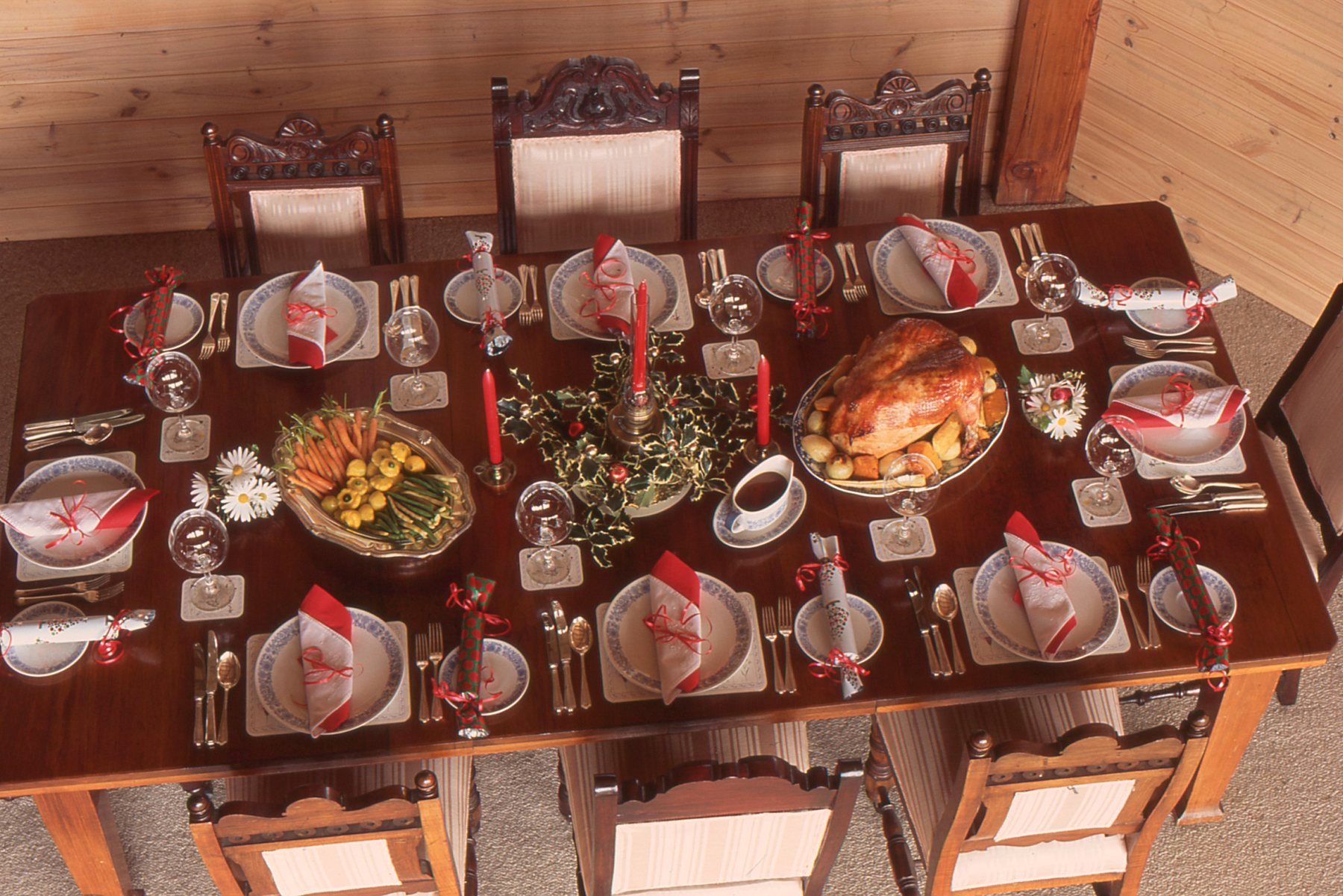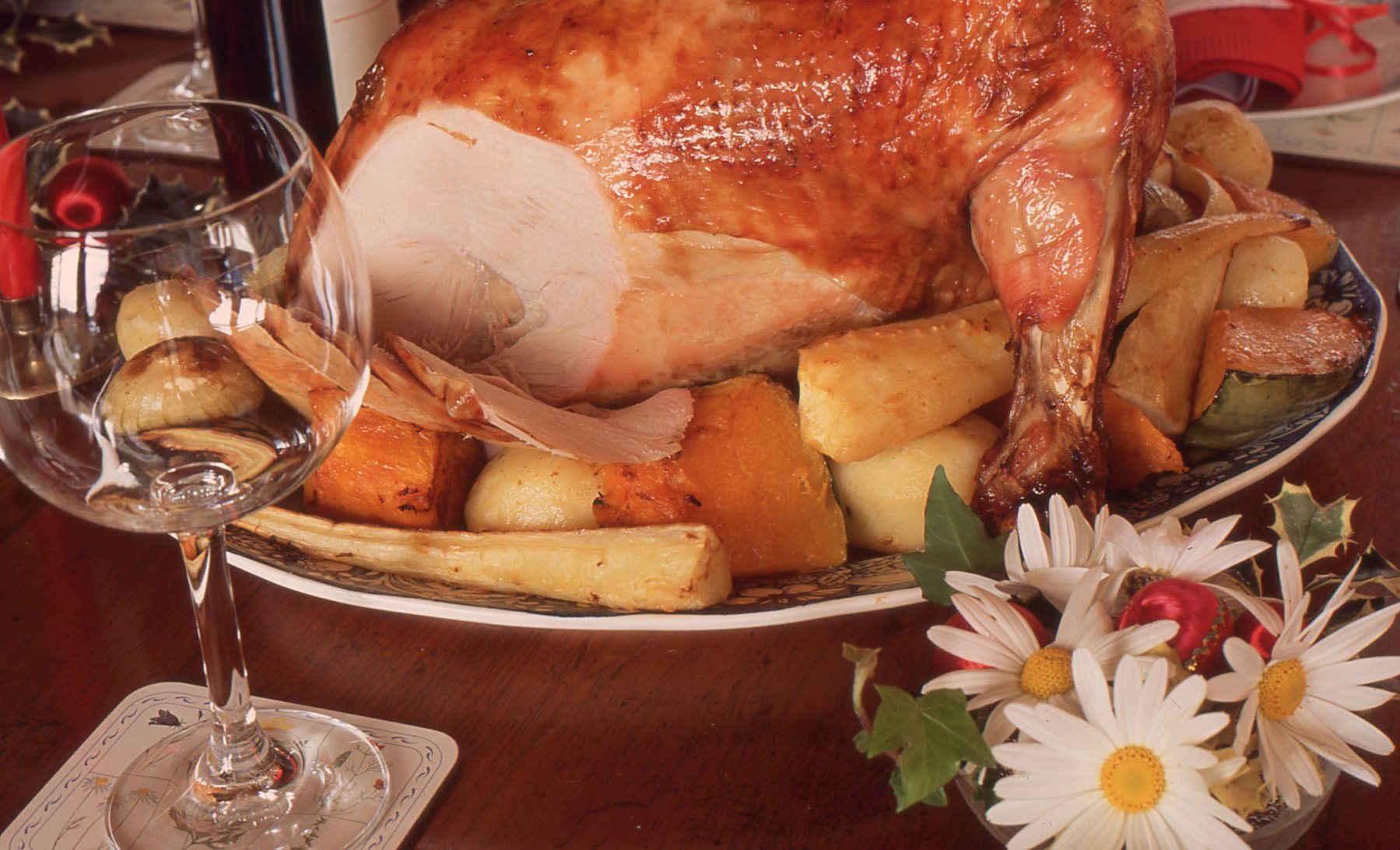(Continued from Traditional Christmas Dinner – Part A)
For a traditional Christmas dinner we propose: a seafood cocktail, roast turkey with vegetables followed by plum pudding with brandy sauce. This post and the next continue from an article we wrote for Club Marine magazine in 1993. (Use the Print button at the top of this page for a hardcopy or pdf of the recipe in this post.)
Sasha’s turkey
Even though you may be confident about cooking a whole, standard turkey, Sasha (former owner and chef of Poffs restaurant, Red Hill, Mornington Peninsula) recommends using a buffet turkey. It is not a whole bird but consists of just the top-half (or breast) section. Some may have been pre-treated with oils and spices. The breast is the more delicate part and consists of all white meat. Done properly, it does not dry out, as can happen to standard turkeys. The end result is succulent and moist; leftovers remain this way for several days in the refrigerator and make for delicious salads and sandwiches. Buffet turkeys can be bought frozen from the supermarket and come in a large range of sizes (weighing from three kilograms to eight or more). Because of the bone, allow 350 to 400 grams per person. No stuffing is required. Allow to thaw a couple of days ahead of time.
Depending on its size, allow about three hours to finish the turkey, this includes a half hour or more at the end to finish off vegetables, make the sauce and allow the cooked turkey to rest. Work out the cooking time depending on the weight: use 20 to 30 minutes plus 20 to 25 minutes per kilogram. You may wish to make traditional gravy by cooking flour in the drained pan juices then adding stock, wine or water. Alternatively, as there will be plenty of juice left in the pan, you may wish to try Sasha’s method given below. It will not take much longer, provided you have the ingredients prepared beforehand. The result is a smooth, sophisticated sauce which is well worth the effort.
To cook the turkey, set the oven at 1800C (fan forced). Drain the bird, rinse and pat dry. Rub lightly with oil; salt and pepper lightly. Firmly pull the wing bones outwards to allow for more even cooking. Place in a baking dish with the cavity on the base and the rounded breast up. Bake for 20 to 30 minutes until golden brown. Add 2 cm of white wine to the base of the dish. Cover the turkey loosely with a large piece of foil to stop it from burning. Continue to bake for another 2 hours or so for a 6 kilogram turkey. To check if cooked, use a fork to pierce the thick flesh between the wings near the bone; if red juices still run, allow another 15 minutes. When cooked, the turkey can be kept warm for up to an hour outside the oven by wrapping in foil, then plenty of newspaper or tea towels or both. It is advisable to let the cooked turkey rest like this for at least 20 minutes before carving as it allows the juices to spread evenly throughout the bird.
While the turkey is resting, finish off the vegetables and make the sauce or gravy. Serve with a range of vegetables including roasted potatoes, onions, pumpkin, parsnip, sweet potato or carrots and steamed or boiled asparagus, broccoli, brussels sprouts, beans, squash or freshly shelled peas or broad beans.
Turkey sauce
This sauce takes 20 to 25 minutes to finish so make sure all the ingredients have been prepared beforehand and are set aside ready to use. Home made stock will provide the best results – Sasha uses a thick, reduced beef stock – but you can use the equivalent in water and good stock cubes, or bought stock.
- one medium onion, carrot and stick of celery, finely chopped
- 1 medium clove garlic finely chopped
- 2 bay leaves
- sprigs of parsley, thyme or rosemary
- several peppercorns
- 2 tbsps tomato paste
- 1 cup white wine
- 3 to 4 cups good beef, veal or poultry stock
- 1/3 to 1/2 cup beurre manié (see separate note below)
- salt and pepper
When the turkey has been removed, retain all the juices in the same baking dish and heat on the hot plate. Add the finely diced vegetables, garlic and herbs and cook at a fast simmer for 10 to 15 minutes. Stir in the tomato paste. Pour in the wine and the stock and simmer for a further 10 minutes, stirring to dislodge and dissolve any solids on the side of the pan. Pour through a fine strainer into a saucepan, discarding the strained vegetables. Spoon the fat off the surface of the saucepan. Bring back to a simmer but not a boil, then thicken the sauce using the beurre-manié: add this in teaspoon sized pieces to the simmering stock and stir well after each addition. Use your judgment as to when the sauce is thick enough. Adjust for seasonings. Keep warm until ready to serve. Pass around the table in a sauce boat.
Beurre manié
Beurre manié provides a useful way of thickening sauces with flour at the end of the cooking time, reducing the chance of lumps. Here we use it to thicken both the turkey sauce and the brandy sauce (in the next post).
You will need about a cup in total of beurre manié for the two sauces. To make this amount combine 4 tablespoons of plain flour with 6 tablespoons of softened (but not melted) butter. Mash with the back of a fork until well combined and looks like a thick paste or soft dough. Store in the refrigerator for up to two weeks.
To thicken a sauce, add to simmering liquid in teaspoon sized amounts (several amounts can be added initially). After each addition, stir or whisk in well then bring the liquid back to the boil to cook the flour and check for thickness. Continue adding pieces to the simmering sauce until the right thickness has been achieved.
Continued in Traditional Christmas Dinner – Part C




